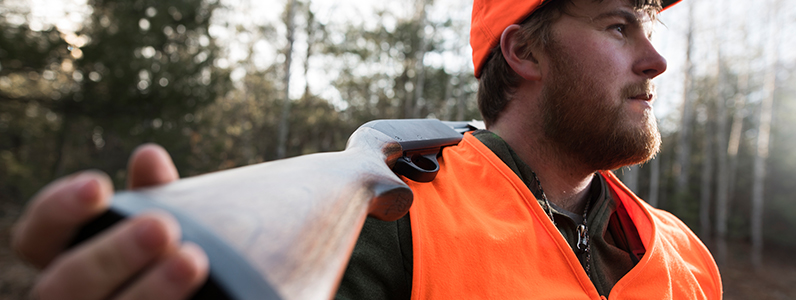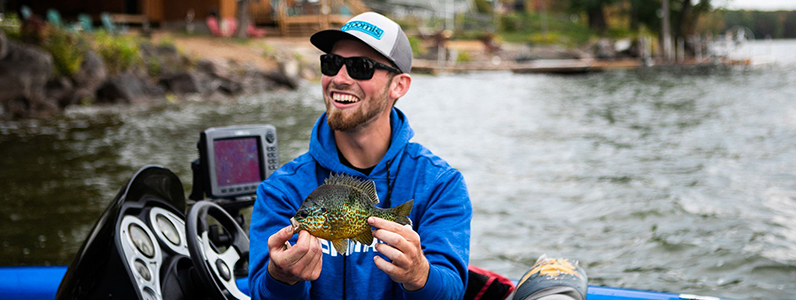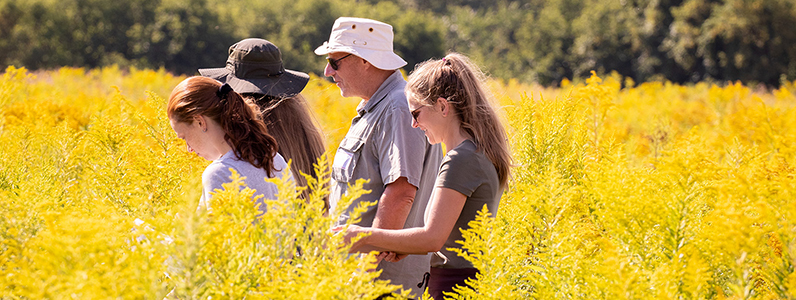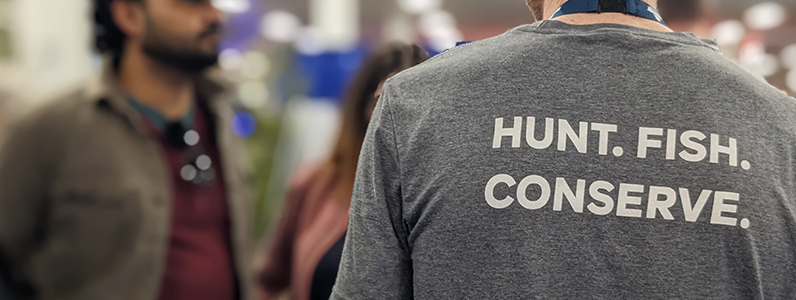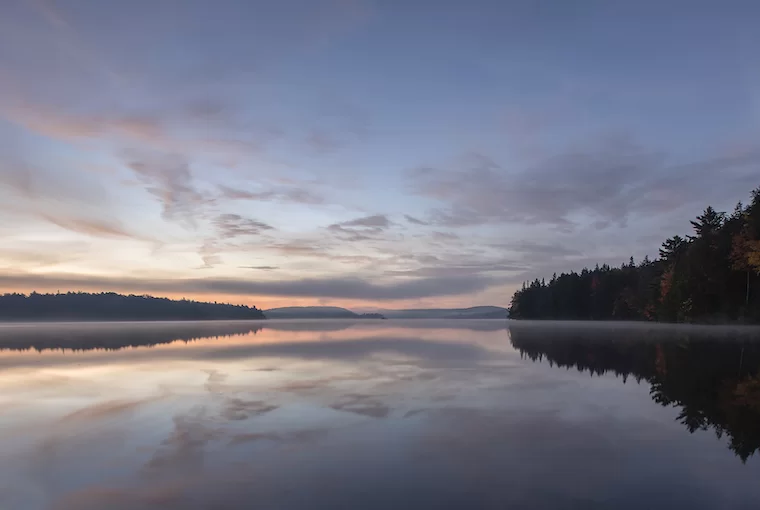ECO-FRIENDLY TRAVEL TIPS
Algonquin: Ontario’s most famous park
“Somewhere down there lives the brook trout of my dreams.” That is the recurring thought I have whenever I gaze into the waters of Algonquin Provincial Park. On my last trip, I didn’t catch it. But I caught one that gave me hope — a beautiful 19-inch squaretail that came close to being the size of my canoe paddle blade.
I can still see it rise and slash at the white beadhead woolly bugger I was stripping in from a near-shore cast. I recall the way the fish turned towards the depths in a swift, dramatic arc, leaving the fly untouched. And I remember how, in an uncharacteristic act of good angling judgment, I stopped the retrieve and let the fly hover and slowly descend. The fish rose again. The fly was taken. Another memory was made.
Any angler who has spent time there understands. Quality fishing, unspoiled waters, and the feeling that there’s always more wilderness to discover and bigger fish to net.That is what the park brings to the table. That is what makes it world-renowned, legendary, and the centrepiece of countless stories.
Yet it lies within easy reach of most anglers in the province.
Angling heaven
Algonquin’s allure is tied to its vastness. It encompasses 7,630 square kilometres, most of it wilderness — making it substantially larger than Prince Edward Island. Approximately 1,500 lakes are contained within its boundaries. Many of them remain relatively untouched too — for they cannot be accessed by roads or power boats. The park is criss-crossed by more than 1,200 kilometres of flowing water, from serene brooks to powerful rivers.
It is renowned as a destination for hikers, campers, backcountry kayakers, and canoeists, but it is also recognized for offering quality angling. For many Ontario anglers, a fishing season would not be the same without at least one trip.
I count myself among those folks. I have visited annually for more than 20 years. Typically, I venture several times a season beyond its gates for day trips (I live close enough to do this). I also try to get one backcountry canoe camping trip in each year. And the only thing any of those trips have in common is the regret felt on that last cast. The park is my favourite place to fish.
The fish
Like many anglers, I am drawn there by its brook trout. I have caught hundreds there over the years, including several 20-inchers. But I have yet to net one any bigger, though I have lost a couple that fit that description within heartbreakingly easy reach. (I blame it on a 10-and-a-half-foot fly rod and two-and-a-half-foot arms.)
Nevertheless, I am certain that when my biggest southern Ontario brook trout comes to net, it will be from these waters. The park imbues you with that kind of faith.
Brook trout are not the only angling attraction here, however. I have also caught my biggest river smallmouth on the fly there — a chunky 20-incher battled in a swift-flowing stream. And I have seen others that made that one look small. It’s no wonder anglers target them in summer.
I have also had the good fortune to chase lakers on Lake Opeongo with other anglers who value the copper line and lead-core opportunities that this big, brawny lake provides.
I have bushwhacked along a ridge that was carpeted with more moose and bear scat than I have ever seen, to get to a backwoods brook trout pond that a late friend used to speak of in conspiratorial tones.
And he was right to do so. The brook trout there loved our grasshopper imitations. I have visited the park with fly rod in hand near 100 times. In any other place, that would make you an old hand. But in the park, that barely scratches the surface. And that too is the beauty of the place.
I won’t recommend which waters to visit because there are simply too many good ones. Besides, the real joy of fishing the park comes with exploring and discovering new angling nirvanas for yourself.
Day trip fishing
If you plan on a single-day fishing trip, there are many options off the Highway 60 corridor, which runs for 65 kilometres, from the West Gate, near Dwight to the East Gate near Whitney. There are also options from other access points on the park’s periphery.
Wading anglers, or those with float tubes, can target brook trout or smallmouth bass on flowing waters close to the highway or the secondary roads off it.
Ambitious float tubers have the added bonus of being able to use one of several backpacking trails off access points or trailheads along the highway to hike to lakes that are a little more off the beaten path. I would highly recommend scouting the trails and the access to water they offer prior to making that effort, however. The last thing you want to do is carry in gear and a float tube several kilometers in, only to find out the blue feature on the map is not conducive to their use.
Paddling and the park are, of course, synonymous. Those who bring a canoe or kayak (or rent one at one of the outfitters near or in the park) will have many lake options and, depending on the lake, might even have time to portage to other nearby less-pressured lakes.
Unique experience
There are also several lakes along the corridor that allow power boats, but boaters need to be aware of outboard motor restrictions on those lakes. This is one of the things that makes angling in the park unique. Power boats are not permitted or even an option on most lakes, but in those waters where they are, tin boats and small out-boards are the norm. It’s fishing old school.
Most Highway 60 corridor lakes offer lake trout, smallmouth bass, brook trout, and panfish. Most flowing waters there are inhabited by brook trout or smallmouth bass. And though these waters face far more angling pressure than the backcountry lakes and creeks, every year some pretty good fish still come out of them. In fact, I have witnessed two five-pound brook trout caught on waters within 200 yards of Highway 60 as well as several truly excellent smallmouths.
If you are extremely competent and comfortable with backwoods navigation, you might also try bushwhacking to a backwoods pond or section of creek or river that likely sees very few people. There are many of these to discover. (Any time you are doing this, make sure you let someone reliable know of your intentions. It’s a big park.)
Day trips are a great way to go for the newcomer since no campsite reservations are required and you can carry a little more if you don’t venture too far from your vehicle.
Drive-in camping
Some anglers, such as those with young families, might want to fish and explore the easily accessed corridor waters over a few days, rather than head into the backcountry or just visit merely for a day. There are 10 developed drive-to campgrounds along Highway 60 and two in the northern section of the park, off the Trans-Canada Highway. These sites can be used as a base for multi-day fishing and camping trips along Highway 60 and, further north, off the Trans-Canada.
There are also lodges in the park that might be considered.
Backcountry camping
The park rewards the adventurous angler. And the most common path to adventure is by way of paddle and portage. A canoe or kayak is required if you want to venture and fish the hundreds of backcountry lakes or the creeks and rivers that flow into and out of them.
There are two types of backcountry anglers. There are those who have found their dream waters and are content to re-visit them each year. And there are the explorers who are on a continual quest for those places where brook or lake trout grow as long as your arm.
You’ll eventually figure out which one you are.
Ideally, a newbie would tag along with more experienced park enthusiasts or even a guide. People such as these will be able to tell you what’s important in terms of fishing tackle and will show you the gear that’s worth taking along.
That’s not the only way, however. The inexperienced, self-guided angler can enjoy the experience too, provided they recognize their limitations. My advice is to initially pick straightforward there-and-back routes or loops that take you to the angling destination that you researched. Start with relatively easy ones.
These initial trips are akin to paying your dues. But they will be the easiest and most pleasant dues you have ever paid, and you’ll look back on them fondly. With each backcountry trip you will learn the skills and gain the confidence needed for more challenging forays. There is a pride that comes with that too — and it sticks with you as you drive home and recall the adventure. While you will probably always be eyeing lakes on the map that are deep in the wilderness, you do not have to go too many portages back to find excellent fishing.
Simple pleasures
Backcountry fishing trips in the park will transport you away from our chaotic world to a simpler place where you can clear your head. And also immerse yourself in a wilderness setting that offers uncrowded, high-quality angling. There will be many times, when it seems like you have a whole lake all to yourself.
The fish are there but not always easily earned. The cost is often high in portages, blackfly and mosquito bites, wet feet, and sore muscles. Because of this you will value your catches more and feel a greater sense of accomplishment.
The further into the backcountry you go, the more wilderness and seclusion you’ll find. And that too, is addictive.
Those truly daunting trips, with multi-kilometre portages over rugged terrain are for the old hands who have pared their gear down.And gained the confidence and experience to be at home in the backcountry. Gear is also more important on trips like these. Your goal should be to pack lighter. Each bit of gear should have a proven track record and purpose. Again, do your research. Outfitters, in and around the park, can offer guidance.
Backcountry angling in the park — the kind that involves portages — requires navigational skills (sometimes finding a portage isn’t as easy as you’d think). And sound judgment and skills when it comes to flowing and open water canoeing. Knowing how to adapt and read the weather is also helpful. When you are more than a few kilometres from the road, you need to know what you are doing. A compass and map are essential. And electronics like a handheld GPS and satellite messenger, like a Garmin inReach, are also worth considering.
The wilderness experience
As fine and varied as it may be, angling is just a small part of the park’s appeal. The other great draw is the wilderness experiences it provides. For me, the backcountry begins at the first portage. On those rugged trails, where you sluff the weight of the world off your shoulders and replace it with the more pleasant heft of canoes and packs. By the time you arrive on the far side of a portage, you will be reminded what you are capable of. Visit the park enough and you will view the wilderness in a different way — and you will miss it like you miss an old friend.
And it will be worth it. For in places like these you will see a moose swimming across the lake in the early morning mist. Or a multitude of impossibly bright stars unveiled as clouds part to reveal an undiluted night sky. Settings like this etch little memories forever into your mind — brook trout chasing tadpoles in the shallows, otters playing by your canoe, the sparks of a crackling campfire rising into the night sky. Memories of a sublime shore lunch.
Rooted in history
The park is nothing short of iconic. It is a wondrous country of its own. Its anthem is the cry of the loon at dawn. Its hymn is sung by a wolf pack in the dead of night. The history is written in the rough-hewn log furniture that surrounds the campfire ring and on the signs that announce where the portages begin and where the campsites lie. Sometimes its story is told by the wind, as it fiercely riles up whitecaps across the lake ahead of you. Sometimes it is recited by the solemn call of a distant barred owl.
No matter how it is conveyed, the story is also yours to retell.
Go out there and create your own Algonquin memories. Chase that brook trout of your dreams. It’s waiting somewhere out there.
Learn about the park before you go. One excellent website is www.algonquinpark.on.ca
Originally published in Ontario OUT of DOORS’ 2023 Fishing Annual
